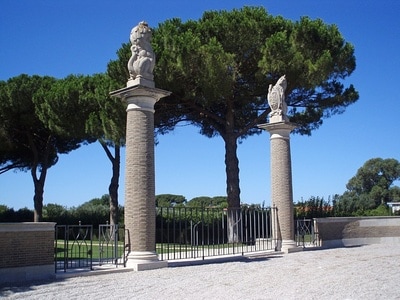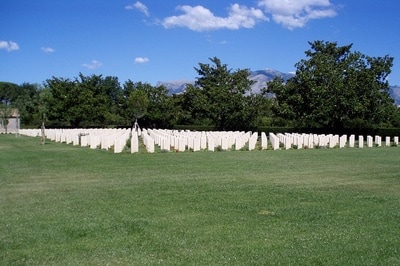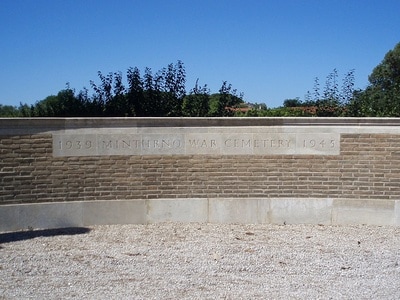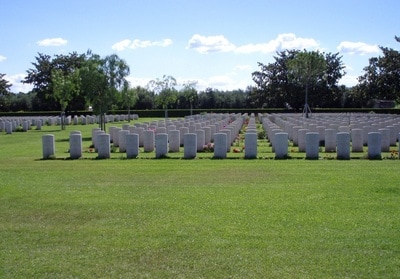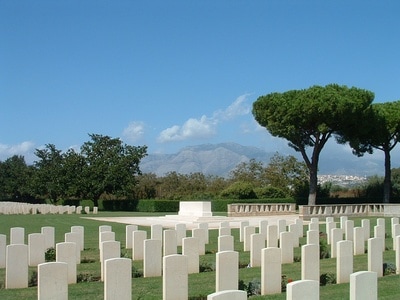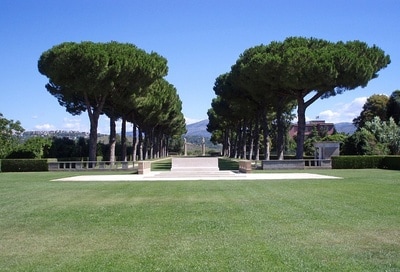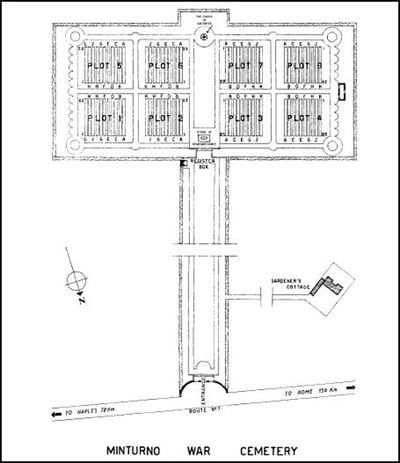MINTURNO WAR CEMETERY
Marina di Minturno
Italy
Location Information
Minturno is about 78 kilometres north of Naples, close to the coast. The cemetery lies several kilometres south of the town on the SS7 road to Naples and is situated in the locality of Marina di Minturno (Garigliano). To reach the cemetery take the Cassino exit from the A1 motorway, then turn right to follow Ausonia, Formia, Minturno. At about 30 km the road runs tangientially to a flyover. Go under the flyover, turn left and take the SS7 Appia road towards Scauri and Naples. Go over Scauri and then, after 4 kilometres, to Marina di Minturno and the cemetery is a further 3 kilometres, on the right hand side.
Cemetery address: Via Virilassi, 1 - 4020 Marina di Minturno (LT) Lazio.
GPS Co-ordinates:
Main entrance to cemetery; Latitude: 41.243006, Longitude: 13.766556
Back entrance gate to cemetery; Latitude: 41.240844, Longitude: 13.765905.
Visiting Information
The cemetery is permanently open and may be visited anytime.
Wheelchair access to the site is possible via an alternative entrance.
Historical Information
On 3 September 1943 the Allies invaded the Italian mainland, the invasion coinciding with an armistice made with the Italians who then re-entered the war on the Allied side. Allied objectives were to draw German troops from the Russian front and more particularly from France, where an offensive was planned for the following year.
Progress through southern Italy was rapid despite stiff resistance, but by the end of October, the Allies were facing the German winter defensive position known as the Gustav Line, which stretched from the river Garigliano in the west to the Sangro in the east. Initial attempts to breach the western end of the line were unsuccessful and it was not until 17 January 1944 that the Garigliano was crossed, and Minturno taken two days later.
The site for the cemetery was chosen in January 1944, but the Allies then lost some ground and the site came under German small-arms fire. The cemetery could not be used again until May 1944 when the Allies launched their final advance on Rome and the US 85th and 88th Divisions were in this sector. The burials are mainly those of the heavy casualties incurred in crossing the Garigliano in January.
Minturno War Cemetery contains 2,049 Commonwealth burials of the Second World War.
The cemetery was designed by Louis de Soissons.
Cemetery pictures used with the permission of the Commonwealth War Graves Commission
Minturno is about 78 kilometres north of Naples, close to the coast. The cemetery lies several kilometres south of the town on the SS7 road to Naples and is situated in the locality of Marina di Minturno (Garigliano). To reach the cemetery take the Cassino exit from the A1 motorway, then turn right to follow Ausonia, Formia, Minturno. At about 30 km the road runs tangientially to a flyover. Go under the flyover, turn left and take the SS7 Appia road towards Scauri and Naples. Go over Scauri and then, after 4 kilometres, to Marina di Minturno and the cemetery is a further 3 kilometres, on the right hand side.
Cemetery address: Via Virilassi, 1 - 4020 Marina di Minturno (LT) Lazio.
GPS Co-ordinates:
Main entrance to cemetery; Latitude: 41.243006, Longitude: 13.766556
Back entrance gate to cemetery; Latitude: 41.240844, Longitude: 13.765905.
Visiting Information
The cemetery is permanently open and may be visited anytime.
Wheelchair access to the site is possible via an alternative entrance.
Historical Information
On 3 September 1943 the Allies invaded the Italian mainland, the invasion coinciding with an armistice made with the Italians who then re-entered the war on the Allied side. Allied objectives were to draw German troops from the Russian front and more particularly from France, where an offensive was planned for the following year.
Progress through southern Italy was rapid despite stiff resistance, but by the end of October, the Allies were facing the German winter defensive position known as the Gustav Line, which stretched from the river Garigliano in the west to the Sangro in the east. Initial attempts to breach the western end of the line were unsuccessful and it was not until 17 January 1944 that the Garigliano was crossed, and Minturno taken two days later.
The site for the cemetery was chosen in January 1944, but the Allies then lost some ground and the site came under German small-arms fire. The cemetery could not be used again until May 1944 when the Allies launched their final advance on Rome and the US 85th and 88th Divisions were in this sector. The burials are mainly those of the heavy casualties incurred in crossing the Garigliano in January.
Minturno War Cemetery contains 2,049 Commonwealth burials of the Second World War.
The cemetery was designed by Louis de Soissons.
Cemetery pictures used with the permission of the Commonwealth War Graves Commission
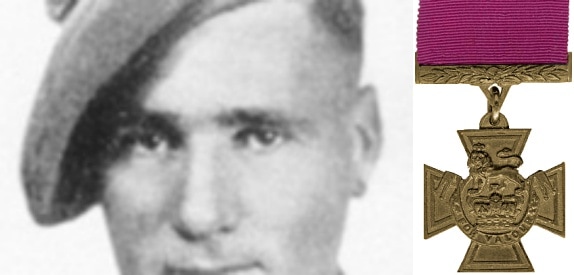
3252325 Private George Allan Mitchell, V. C.
1st Bn. Gordon Highlanders, The London Scottish, died 24th January 1944, aged 31. Plot III. H. 19.
Son of Edward Joseph and Florence Emma Mitchell.
Citation: The citation in the London Gazette of 8th August, 1944, gives the following details: On the night of 23/24th January 1944, a company of the London Scottish was ordered to make a local attack on a part of the Damiano ridge, north-east of Minturno. A section of this company was responsible for carrying out a flanking attack on some enemy machine-guns which were holding up the advance. This section consisted of a Lance-Corporal and three privates, who were joined by Private Mitchell (the 2-inch mortarman from platoon headquarters) and another private. When an enemy machine-gun post opened fire on them at point-blank range, Private Mitchell, dropping his mortar, charged the position alone with a rifle and bayonet, and silenced the gun. Then the advance of the platoon was shortly after held up again, Private Mitchell once more dashed forward, followed by the remainder of his section, who helped him to capture this next German position. Another machine-gun opened fire on the section as it was reorganising, and again Private Mitchell ran forward alone and silenced it, killing the crew. He then led the final assault up to the crest of the hill and was mainly instrumental in forcing the remainder of the enemy to surrender. A few minutes later, he was shot by a German who had surrendered. Throughout this operation Private Mitchell displayed courage and devotion to duty of the very highest order. His complete disregard of the enemy fire, the fearless way in which he continually exposed himself and his refusal to accept defeat so inspired his comrades that together they succeeded in overcoming and defeating an enemy who was both superior in numbers and helped by all the advantages of the ground.
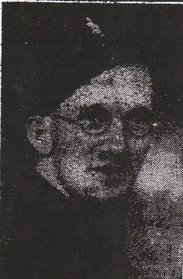
T/198404 Driver
William John Baker
Royal Army Service Corps
9th November 1943, aged 30.
Plot I, A, 15.
Son of John and Fanny Baker Cornwall.
Extract taken from Cornish & Devon Post dated 4th December 1943
News has been received by Mr. and Mrs. John Baker of Trevia, Camelford, that their eldest son, Driver William John Baker, R.A.S.C., died of wounds in November 1943 whilst serving with the Central Mediterranean Force. Thirty years of age, deceased, born at Trevia, joined the Forces early in the war and had not been home for three years. Prior to the outbreak of war he was employed by a firm of Government contractors in Camelford and Penzance and was well known in both these towns. Greatest sympathy is felt for the parents on their bereavement, also with his fiancée and other members of his family. Mr. and Mrs. Baker have another son, Jim, who is also serving his country in France.
William John Baker
Royal Army Service Corps
9th November 1943, aged 30.
Plot I, A, 15.
Son of John and Fanny Baker Cornwall.
Extract taken from Cornish & Devon Post dated 4th December 1943
News has been received by Mr. and Mrs. John Baker of Trevia, Camelford, that their eldest son, Driver William John Baker, R.A.S.C., died of wounds in November 1943 whilst serving with the Central Mediterranean Force. Thirty years of age, deceased, born at Trevia, joined the Forces early in the war and had not been home for three years. Prior to the outbreak of war he was employed by a firm of Government contractors in Camelford and Penzance and was well known in both these towns. Greatest sympathy is felt for the parents on their bereavement, also with his fiancée and other members of his family. Mr. and Mrs. Baker have another son, Jim, who is also serving his country in France.

